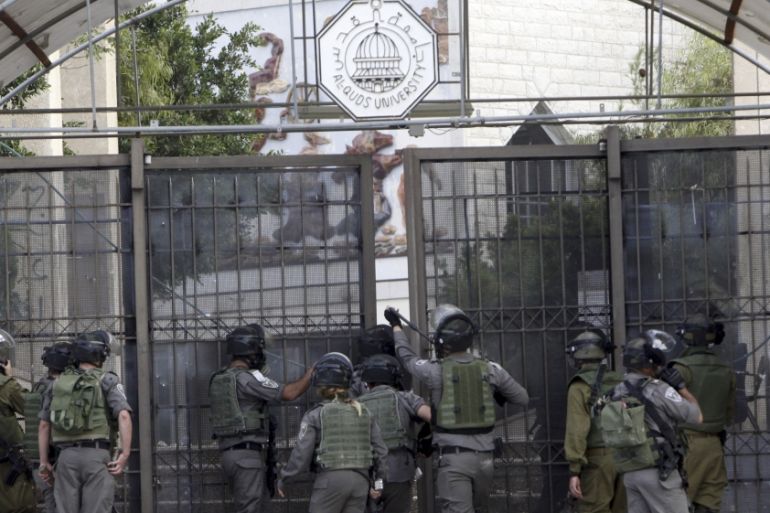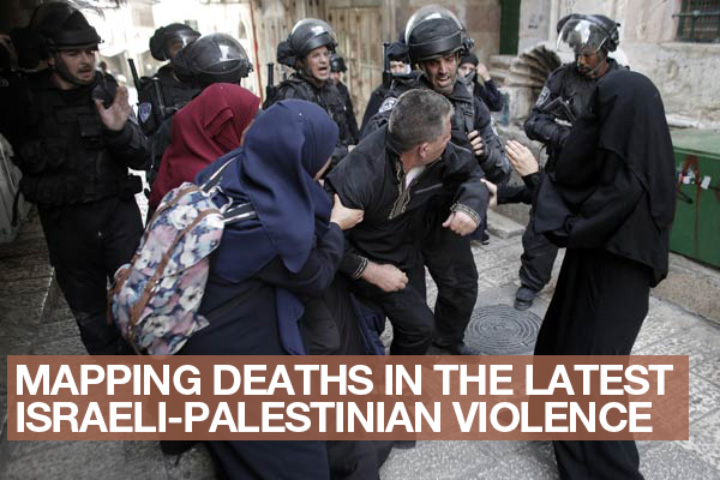Palestinian campus: ‘A wall of fear has come down’
West Bank campuses are the new battleground as confrontations between Israeli army and Palestinian students intensify.

Abu Dis, occupied West Bank – Debris and broken glass were strewn across the Al-Quds University campus in Abu Dis on a recent afternoon, evidence of one of many recent incursions by Israeli forces since October.
Nearby, a group of students carrying Palestinian flags marched off campus towards Israel’s separation wall.
 |
| Palestinian students say a ‘wall of fear’ has come down in the past few weeks [AP] |
A few wrapped their faces in keffiyehs and took turns hitting the wall with a sledgehammer.
Keep reading
list of 4 itemsRussia-Ukraine war: List of key events, day 784
Iraq’s dangerous balancing act between Iran and the US
Russia-Ukraine war: List of key events, day 783
This has become a weekly ritual. So far, the students have managed to carve a deep hole in the concrete, each time picking up where the last demonstration left off.
Another student scaled the wall and planted a Palestinian flag at the top, flashing a victory sign. Local schoolchildren joined in, throwing stones over the wall. It was not long before the Israeli army dispersed them with tear gas.
RELATED: Intifada or not, something powerful is going on
I don't want us to lose this power that we have right now - the power to rebel, to say whatever we want.
These sorts of clashes have become commonplace at a number of educational institutions throughout the occupied West Bank, amid a wave of unrest that has gripped Israel and the Palestinian territories over the past two months.
Last month, Israeli forces entered an elementary school in Hebron, searching students while looking for stone throwers. According to Palestinian media reports, last Thursday, primary school children in Hebron were prevented from accessing their classrooms when tear gas and skunk water were fired at the school in one of many similar incidents.
The Palestine Technical University of Kadoorie, located in the West Bank city of Tulkarm, has also found itself at the heart of the conflict. Over the past six weeks, there have been daily confrontations between students and Israeli soldiers, university spokesperson Azmi Saleh told Al Jazeera.
“In the past week, there have been excessive violations on the campus itself as forces reached the main administration building,” Saleh said. “Since October, we have had to evacuate the premises at least 10 times due to tear gas or skunk water.”
The university was also shut down for two days, forcing all of its 7,000 students to stay home, he added. At least nine students from Kadoorie have been arrested since October, five of whom were taken from the campus.
Asked to comment, a spokesperson said the Israeli army does not have a policy of raiding campuses and school premises.
Students maintain it is a significant issue, however. “In the past two years, the soldiers have been entering the campus, and it’s been getting more tense,” said Nadine Swaity, a fourth-year media student at Al-Quds. “Once they came in when we were gathered, singing. It was surreal. There were no clashes, nothing at all. Just us singing.
“For me, it’s clear why they do it: because education is a stronger weapon than stones,” Swaity told Al Jazeera. “The idea of limiting us – it’s not just limiting our movement, it’s about limiting our thinking.”
Swaity pointed to the separation wall, which runs alongside the perimeter of the campus and is clearly visible from common areas and many of the classrooms.
“It’s not just to separate us from Jerusalem,” she said. “It’s a symbol of power and it works somehow because some people are afraid of saying anything about what they witness.”
Still, she believes a “wall of fear” has come down in the past few weeks, at least for some young Palestinians: “I don’t want us to lose this power that we have right now – the power to rebel, to say whatever we want.”
FORUM: How can Palestinians legally fight the occupation?
|
|
According to prisoner support group Addameer, Israeli forces arrested 1,195 Palestinians across the occupied West Bank in October, including 128 through administrative detention orders.
Nearly a quarter of the administrative arrests related to allegations of incitement through social media.
Since October 1, protests across the West Bank have left more Palestinians injured than in all of 2014, according to the UN Office for the Coordination of Humanitarian Affairs, which has recorded 7,040 injuries up until November 9.
In the same period, across the West Bank, Israel and Gaza, at least 85 Palestinians and 16 Israelis were killed. At least 128 Israelis were injured during the same period.
Meanwhile, the image of Muhannad Halabi, the 19-year-old who stabbed and killed two Israelis in the Old City of Jerusalem before being shot dead last month, has become ubiquitous across the Al-Quds campus.
“It’s not organised with a goal; it’s more emotional,” said Zaki, who spoke to Al Jazeera using a pseudonym. “It becomes more about your university, protecting your community. But I don’t think that in the end it will lead to anything.”
RELATED: Children of Hebron: ‘Everyone is afraid’
 |
“If it gets more intense, it will disrupt everything in our lives,” Shahd Sataria, a 20-year-old international law student at Al-Quds’ Bard College who dreams of becoming a broadcast journalist, told Al Jazeera.
“It will be even harder than it already is. At the same time, if nothing happens, the oppression will still be there.”
Adel Hussein, an accounting student at Tulkarm University, has started using art to express his frustrations over the situation. Many of his cartoons feature children. His cartoons are about the exploitation of Palestinian workers, Al-Aqsa Mosque, and the blockade of Gaza.
“I draw the children of this Intifada, about what is happening in Jerusalem, about the occupation,” he said.
“For me, there is nothing else I should be drawing about.”